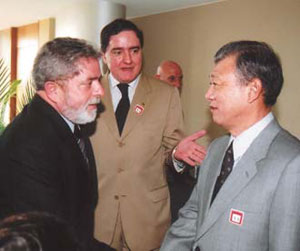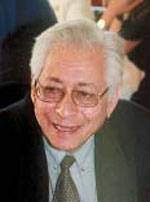|
AMBASSADOR'S JOURNAL
A Study in Contrasts
WHO Goodwill Ambassador Yohei Sasakawa's travels take him to South America - to two countries that have had very different experiences of leprosy - and to Switzerland, where the 56th Session of the Sub-Commission on the Promotion and Protection of Human Rights was being held in Geneva.
CHILE
In late June and early July 2004, I visited Chile and Brazil. My visit to Chile was primarily to attend a ceremony in connection with The Nippon Foundation's funding of a scholarship program at the University of Chile, but I also took the opportunity to learn something of the history of leprosy in Chile and the present status of the disease there.
In mainland Chile, there are almost no records of leprosy patients having existed. The only known cases were 4,000 kilometers away on Easter Island, where up until fairly recently there was a leprosy hospital and a small number of patients. Five years ago, a survey of the island's 3,000 inhabitants turned up three patients. They were of Polynesian extraction, and had contracted leprosy in Peru and elsewhere when working as bonded labor.
According to a Chilean dermatologist I met, the reasons why Chile has not suffered from leprosy include: the temperate climate; Chile's distinctive topography - a long, narrow country bordered on one side by the Pacific, and on the other by the Andes, effectively turning it into an island; and an immunity built up through BCG and other vaccination programs. He even suggested that there might be something about the Chilean DNA that kept the country free of leprosy. Based on what I have seen of leprosy, I'm not sure I agree with these reasons. But for now, it remains rather a mystery why Chile has had almost no cases of leprosy.
BRAZIL
I next went to Brazil to update myself on the current leprosy situation and attend a meeting of representatives of WHO, the Brazilian government and others involved in leprosy elimination.
Unlike Chile, Brazil is a leprosy-endemic country that, after India, has the highest number of registered cases in the world. In 2002, of the country's 5,500 municipalities, 3,521, or 60%, have registered leprosy cases. According to the most recent government statistics, there are about 80,000 patients and the PR stands at 4.52/10,000. There is a particularly high incidence of the disease in the Amazon basin and other areas where it is difficult to provide medical services.
In my capacity as WHO Goodwill Ambassador, I met with President Luis Inacio “Lula” da Silva, and called on his government to make greater efforts for leprosy elimination. He indicated his determination to do so, saying, “We could have solved this problem of leprosy long before, but we did not try hard enough.
We need to make up for lost time.”
Much work will be needed. Based on what I heard from many people, the efforts of past administrations were sorely lacking. Official figures for the number of patients and the prevalence rate have remained virtually unchanged for six years, up to 2003, and the person now in charge of leprosy at the health ministry admitted that the official figures were not to be trusted.
Since the statistics published by the government fail to reflect the actual situation, this poses a real obstacle to implementing an effective elimination strategy. The present administration has recognized this, and made a number of personnel changes designed to achieve results. “We were asleep,” a senior official of the health ministry confessed. Under President Lula and the new health minister, however, a new strategy is taking shape.
Elimination at the national level is targeted for 2005, and at the municipal level for 2010, and there is reason for optimism about the future.
If government efforts in the past may have come up short, the same cannot be said of the NGOs and volunteers that have sought to fill the gap. MORHAN (Reintegration Movement for People Affected by Hansen's Disease), an NGO set up 23 years ago by Francisco Nunes “Bacurau,” himself a leprosy-affected person, has been operating a nationwide leprosy helpline called Telehansen. The toll-free service answers 18,000 calls a year. Of these, 47% are from people affected by leprosy and are mainly concerned with questions about how to diagnose leprosy and how to obtain MDT.
 Yohei Sasakawa meets with President Lula of Brazil (left).
While Brazil still faces many difficulties, there are grounds for hope that the situation will start to improve.
In the regions, few of Brazil's health centers have resident doctors, and must rely on routine visits. As a result, there are often no doctors present when people with the disease turn up, which means they can't be examined and treated.
This helps to explain why Telehansen receives so many calls on these topics.
MORHAN also wields considerable influence over the government in its capacity as a private pressure group and was very critical of the government's performance in the past. But what was apparent on this visit to Brazil was the good and constructive relationship that now exists between MORHAN and the ministry, working together in a powerful partnership toward a common goal.
There is one more aspect of Brazil's involvement with leprosy that I should like to mention: the work of well-known celebrities, two of whom I met on my visit. Actress Elke Malavilha has been meeting with residents of hospital colonies for the past 15 years (see page 5); Ney Matogrosso, one of Brazil's most popular singers, has been taking part in nationwide leprosy elimination campaigns via TV and other media.
What celebrities such as these, and groups such as MORHAN, are doing is admirable.
Together with the forward-looking attitude of President Lula's administration, they left me with the impression that while Brazil still faces many difficulties, there are grounds for hope that the situation will start to improve.
SWITZERLAND
On July 29, I organized a working luncheon in Geneva for the members of the Sub- Commission on the Promotion and Protection of Human Rights*. The 56th Session of the Sub-Commission was being held from July 26 to August 13 and the luncheon was designed to put the problem of leprosy and human rights before members and urge the Sub-Commission to take up the issue in its agenda for discussion.
Prior to this, I had met Deputy High Commissioner for Human Rights Bertrand Ramcharan in July last year. At his suggestion, in August 2003 The Nippon Foundation led the first group of experts including people affected by leprosy to visit the Sub-Commission meeting in Geneva and raise the issue. Then, in March 2004, speaking as an NGO representative, I made the first-ever presentation on leprosy as a human rights problem at the 60th meeting of the United Nations Commission on Human Rights (UNCHR).
At the lunch I organized this summer, 22 out of the Sub-Commission's 26 members attended and heard presentations by Dr. Kenzo Kiikuni, Chair, Sasakawa Memorial Health Foundation, and me on the history and current situation of human rights violations involving leprosyaffected people.
The reaction from those present was quite positive and the chairman of the 56th session,
 Mr. Soli Sorabjee
Mr. Soli Sorabjee, India's representative on the Sub-Commission and his country's attorney general, said on behalf of those attending, “Leprosy is an age-old phenomenon that leads to severe human rights violations. We will be happy to do something to support your movement.”
Following this luncheon, the Sub- Commission adopted a unanimous resolution on August 9 to conduct an investigation and produce a working paper on the issue (see page 8 for more details).
I am pleased to note that our efforts are starting to lay the groundwork for an end to human rights violations of those affected by the disease.
Reference
| * |
The 26-member Sub-Commission on the Promotion and Protection of Human Rights is the main subsidiary body of the U.N. Commission on Human Rights.
The 26-member Sub-Commission meets annually in Geneva. |
|